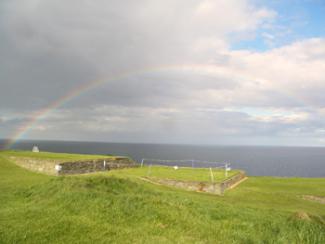Featured Golf News
An Irish Golf Journey Begins at Ardglass & Royal County Down
The trip began with a whiff on the first hole. Yes, sir. A whiff. Might I blame it on jet lag? After all, I had arrived in Dublin on an overnight flight from Boston that morning, with only a catnap for rest, and hurriedly drove two hours into Northern Ireland for a late-afternoon tee time at Ardglass Golf Links in County Down.

The 3rd Tee at Ardglass
Then again, it could have been pure nerves. I was embarking on nine rounds in 10 days at some of the greatest golf courses in the world. Royal County Down. Portmarnock. Ballybunion. Lahinch. Old Head. Doonbeg. Waterville. They were all on the agenda. And here I was, knees rattling, whiffing on a shot for the first time since I can't remember when. Even worse, it came as I stood in the 18th fairway (where my tee shot had landed) as members watched from a few feet away.
I prefer to blame it on the Guinness-fueled late lunch just before teeing off. Whatever. It got better. Or as John Lennon sang in the Beatles' song "Getting Better," it couldn't get much worse.
But on to the golf. As I said, it was the beginning of an Irish golf extravaganza with three old friends. We had journeyed across the pond on a similar trip to Scotland nine years earlier, playing St. Andrews, Turnberry, Muirfield, Carnoustie, Troon, Prestwick, North Berwick, Kingsbarns and Gleneagles. This odyssey started with a flight into Dublin and a two-night stay at the glamorous 115-year-old Slieve Donard Hotel in Newcastle, from where we could view the ocean from our rooms and walk across the back parking lot to the famed Royal County Down golf course.

The 1st Hole at Ardglass
First stop, though, was Ardglass, which according to local members is one of Rory McIlroy's favorite courses. Cannons on the first tee that faced the rock-strewn, rugged coastline told you immediately that this place had serious history. Indeed, the pro shop/clubhouse/restaurant is housed in a former castle that was built in the 13th century. The course was expanded to 18 holes in the 1970s and continues undergoing changes. Three new holes were added in 2003 and, currently, the fourth hole is being played to what was formerly the seventh green and the fifth hole has been taken out of play, to be replaced by the old 17th hole.
Confused? We were. Lacking signs, we wandered aimlessly around the grounds after finishing the third hole before members pointed us in the proper direction.
Ardglass doesn't stand up to Ireland's finest courses in terms of conditioning. Tee boxes are in tough shape and the fairways are a bit unkempt. But turn the discussion to magnificent, dramatic settings, and it holds its own with just about any layout.

The Cannons at Ardglass
The first five holes offer astounding views of the Irish Sea and the Mourne Mountains as the course winds past cliffs, canyons and takes golfers on a rollercoaster ride. The opening tee shot must carry a rock-covered hazard, while the par-3 second is guarded by a gorge with the sea running along the left. No hole is more flat-out unforgettable than the 198-yard, par-3 12th. From its elevated tee, golfers must hit over a gorge to a green that sits in a deep valley, with the sea to the right and a distant lighthouse serving as a target line. The finishing hole, although not especially demanding, is also memorable as you hit onto a downhill fairway toward the castle, with the water on the right and the town on the left. Some have suggested it is reminiscent of the finishing hole at St. Andrews.
The next morning, we picked up our golf bags, walked across the back parking lot of the Slieve Donard, and within five minutes were at Royal County Down. It took about a nanosecond to realize we were at a very special place. There's an aura about Royal County Down, with its narrow fairways framed by purple heather, golden gorse and sand dunes stretching 60 feet high. The Mourne Mountains serve as the backdrop, while Dundrum Bay comes into view on numerous occasions.

Royal County Down's 9th Hole
A tour of the clubhouse is a stroll through history. Among the framed items on the walls is a scorecard from Harry Vardon, dated 1898, when he shot 31 on the front nine. Of more recent vintage is a photograph of two golfers shown from the back, bags slung over their shoulders, walking down the first fairway on a June morning in 2010. Their names: Rory McIlroy and Graeme McDowell.
Designed by Old Tom Morris and modified by Vardon in 1908, Royal County Down measures 7,000 yards from the championship tees and is as complex as any course I've ever played. While stunning in its beauty, it is wickedly punishing. Even the slightest miscues result in unplayable lies or lost balls that disappear into the thick fescue that frames every fairway and guards every green. The so-called "bearded bunkers," which feature overhanging lips of marram, red fescue and heather, only add to the enormous challenge, as do a succession of blind shots. The small, sloping greens are no bargain, either.

The 1st Hole at Royal County Down
Virtually every hole is unique and memorable. But the par-3 fourth and the par-4 ninth stand out. The fourth plays 229 yards over gorse bushes, with bunkers dotting every available spot except for the green. The ninth, at 483 yards, is the money shot for photographs. The elevated tee provides a spectacular view of the mountains, while the fairway sits 80 feet below, surrounded by golden gorse and framed by sand dunes.
The overall experience of playing this truly historic, unforgettable golf course is mesmerizing. There is the sense that nothing has changed in 100 years. It is both a beauty and a beast, certain to both enthrall and frustrate. After the round, my companions struggled to rate Royal County Down. They understood that they had just played a magical course, but were also aggravated by the many blind shots and how easily golf balls were lost.
How many golf balls did I lose? Too many to count. How many times did I pause to savor the surroundings? Too many to count.
We played Royal County Down on a benign day, with warm temperatures and little wind. It still whipped me. But never have I enjoyed such a beating from a golf course.
Next: A journey to Portmarnock Golf Club and The European Club.
Rob Duca is an award-winning sports columnist who wrote for the Cape Cod Times for 25 years, covering golf, the Boston Red Sox, the Boston Celtics and the Boston Bruins. He is now managing editor of Golf & Leisure Cape Cod magazine and has written for a variety of other publications, including Sports Illustrated, the Boston Globe, Yankee magazine and Cape Cod Life.
Story Options
 |
Print this Story |
